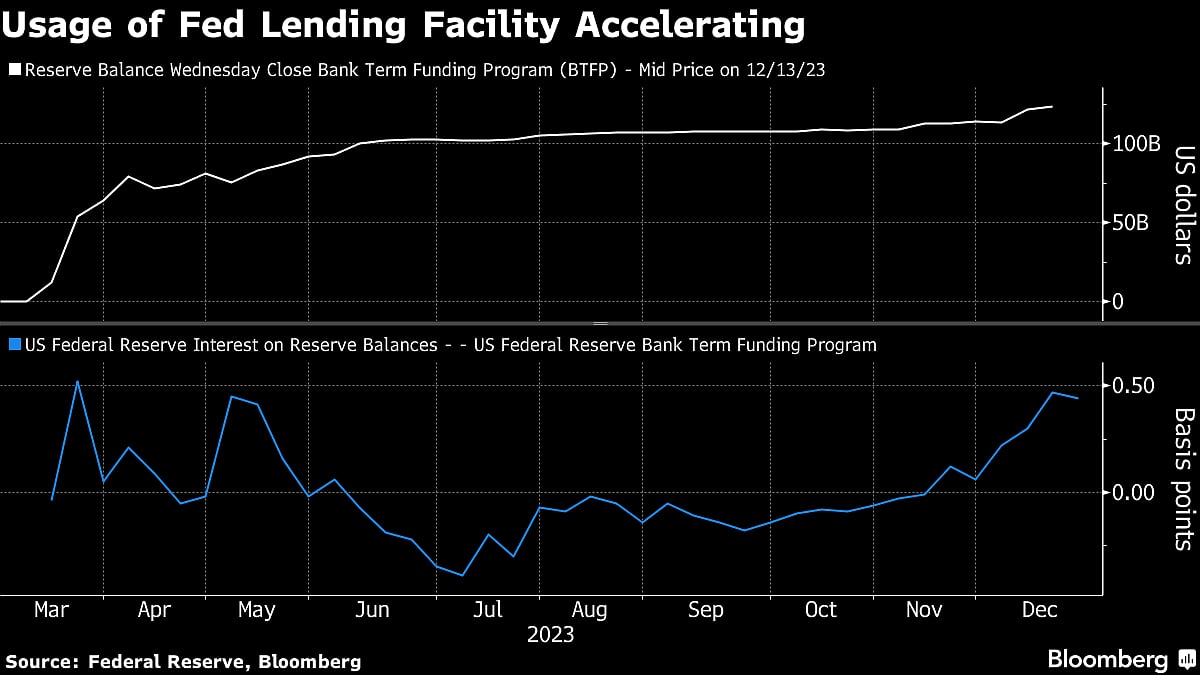Fed’s Newest Tool Has Become More Attractive On Rate-Cut Bets
The Bank Term Funding Program— launched earlier this year as the banking crisis roiled markets — allows banks and credit unions to borrow funds for up to one year, pledging US Treasuries and agency debt as collateral valued at par.

(Bloomberg) -- A Federal Reserve lending facility crafted this March to support ailing banks is looking better than ever after the central bank’s dovish pivot last week as the expectation of aggressive interest-rate cuts makes the rate more alluring.
The Bank Term Funding Program, or BTFP — launched earlier this year as the banking crisis roiled markets — allows banks and credit unions to borrow funds for up to one year, pledging US Treasuries and agency debt as collateral valued at par. The rate for these advances will be the one-year overnight index swap rate plus 10 basis points.
In September, when market participants expected the US central bank to keep rates higher for longer, users of the BTFP would have had to pay roughly 5.61% to use the BTFP. Yet as traders increase bets on more rate cuts in 2024 — about 140 basis points, according to Fed-swaps pricing — institutions are finding it cheaper to tap the nascent facility, currently at 4.96%, than turn to the discount window, which charges eligible institutions 5.5% to borrow cash.
After its introduction in March, usage of the BTFP climbed to $100 billion in June before leveling off. Since the beginning of November, however, banks have tapped the facility for $124 billion in the week through Dec. 13 up from $109 billion on Nov. 1, Fed data show. Wrightson ICAP expects balances to rise after policy makers forecasted a series of cuts next year, especially since the program is expected to expire in March, and estimate another $10 billion increase in the week through Dec. 20.

“At first glance, that 10 bp markup might appear to qualify as the kind of penalty rate typically associated with ‘lender of last resort’ facilities,” Wrightson ICAP economist Lou Crandall wrote in a note to clients on Monday. “In practice, however, the BTFP pricing formula turns it into a subsidy rate when the yield curve is downward sloping.”
Crandall also noted BTFP loans can be prepaid or refinanced at any point without penalty, which means borrowers can get the benefit of lower one-year rates on what are effectively short-term liabilities.
Read more: There’s a Fed Arbitrage for Banks Tapping the BTFP: BPI’s Nelson
The drop in BTFP borrowing costs means that there’s a larger arbitrage for banks to take advantage of, where institutions borrow from the facility and then park the proceeds in their account at the Fed to earn interest on reserve balances — currently 5.40%. That spread is currently 44 basis points after jumping to 51 basis points on Dec. 14.
The window for new BTFP loans expires on March 11, and Wrightson isn’t betting on the program’s extension in the absence of a banking crisis.
The program was easier to support “when it was a critical liquidity support tool designed to stem the risk of bank-run contagion,” Crandall wrote. “It would be harder to justify an extension now that it has morphed into a rate-arbitrage subsidy for healthy banks.”
More stories like this are available on bloomberg.com
©2023 Bloomberg L.P.